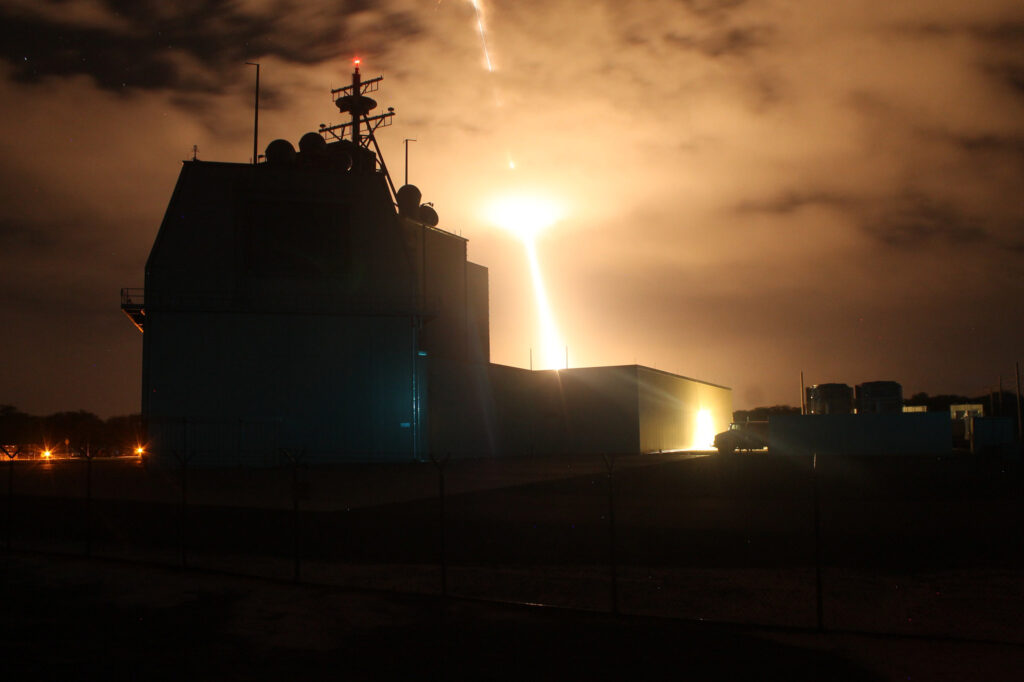
Adm. Philip Davidson, INDOPACOM commander, greats Defense Secretary Mark Esper on a visit to Hawaii.
WASHINGTON: The head of the Indo-Pacific Command wants Congress to give him a powerful new missile defense system, modern training ranges, and billions more for exercises, troop rotations, and other programs designed to blunt China’s growth.
“It’s something I’m engaging on now,” Adm. Philip Davidson told reporters in Washington earlier this week. “I would like to see it be part of FY22 discussions and I continue to have this discussion within the department.”
The ask would be part of a $20 billion, multi-year spending package Davidson delivered to Capitol Hill in April that has gained early bipartisan support from both chambers of Congress. The Republican-controlled Senate’s version of the annual defense policy bill includes $1.4 billion for an Indo-Pacific Deterrence Initiative emphasis new US weapons, while the Democratic-controlled House has $3.6 billion for an Indo-Pacific Reassurance Initiative focused on shoring up allies and partners, but a conference committee will have to thrash out the differences and fill in almost all the details.
On Tuesday, Davidson revealed his top priority is finding money for an Aegis Ashore missile defense system in Guam by 2026. “The most important action we can take to rapidly and fully implement the National Defense Strategy, as a first step, is a 360-degree, persistent, integrated air-defense capability in Guam,” he said.

Aegis Ashore test launch
While he touted the system’s defensive capability, his April proposal suggested any air & missile defense system in Guam could eventually also provide offensive“long-range precision strike capability into the First Island Chain” dominated by China.
With China rapidly improving its arsenal, the admiral said that 2026 would be when “the threat will require us to have a much more robust capability than the combination of THAAD, which is deployed there now, and an Aegis ship in response can provide.”
2026 is also significant because it’s the end of the five-year planning cycle the Pentagon uses to measure its budgeting. If money toward the Aegis system started flowing in 2022, it could wrap up nicely within the five-year window.
But Davidson spoke of the Aegis system’s timeline in terms of Chinese capabilities. “When you look at the way the threat capability, threat capacity, is manifesting from China in the future, whether it’s ballistic missiles from the land, or whether it’s ballistic or cruise missiles from air and maritime platforms, you are going to need a complete clock, a 360-degree coverage, in order to help defend Guam,” he said.
Last month, Japan pumped the brakes on its own plans to build two Aegis Ashore systems on its territory. Japanese Defense Minister Taro Kono said the US government and Lockheed Martin could not find ways to ensure rocket debris won’t fall on local communities.
Tokyo isn’t out of the $2.1 billion program altogether, as discussions continue to try and find a solution. The Japanese navy also operates a number of Aegis-equipped ships that assist in the regional missile defense framework.
Davidson’s desire for a Guam-based Aegis system predates the Japanese waffling, though it might help his cause on Capitol Hill.
The admiral also wants to move offensive weapons forward, calling in his April proposal — first reported by Breaking Defense — for “highly survivable, precision-strike networks along the First Island Chain, featuring increased quantities of allied ground-based weapons,” and a revamped network of training ranges for the US and its allies across the breadth of the region from Alaska to Japan.
Any such network “has got to be able to simulate a higher capacity and capability of potential opposing forces to you,” he said Tuesday. “And then allow you to space the geography, and the networks to exercise and all that going forward.”
It’s unclear what investments Congress will make in the coming years to support Davidson’s plans, though the Aegis Ashore in itself would require a larger American presence at an existing base, at a time when the White House and Pentagon are calling for a shrinking US footprint globally.
Defense Secretary Mark Esper has suggested the Pentagon is concerned that big bases make increasingly easy targets for Chinese and Russian precision weapons, and he’s following President Trump’s lead in formulating plans to shrink some of those overseas installations. Pentagon spokesman Jonathan Hoffman confirmed Tuesday that Esper’s “goal is to remove some of the footprint of having forces forward deployed.”
The use of rotational troops — US-based units that come and go on deployments abroad — could be a way for Pentagon leadership to find a middle ground between Trump’s demands to curtail the US military’s footprint overseas with the Pentagon’s desire to maintain large bases across Europe and the Pacific as staging and logistics hubs.
Army wraps up FLRAA PDR, incorporating special ops design changes
According to a SOCOM official, the Army included feedback from the command that led to design changes like hardware for a refueling probe and features that will enable special operators to make unique modifications.



























